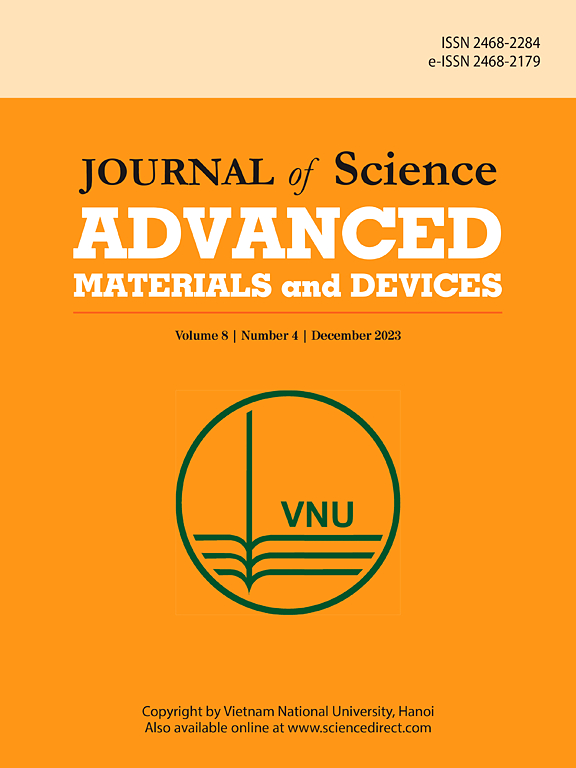具有增强机械和抗菌性能的可生物降解氮化硅3D打印纳米复合材料的制备用于骨组织修复
IF 6.7
3区 材料科学
Q1 MATERIALS SCIENCE, MULTIDISCIPLINARY
Journal of Science: Advanced Materials and Devices
Pub Date : 2025-04-19
DOI:10.1016/j.jsamd.2025.100890
引用次数: 0
摘要
热塑性塑料,如聚醚醚酮(PEEK)和钛植入物,用于医疗和牙科领域。然而,体内经常发生感染和排斥反应。在过去的十年中,金属纳米颗粒作为一种减少微生物感染的替代治疗方法越来越受欢迎,这导致了骨科手术和伤口愈合的创新。最近的研究介绍了新的生物材料骨替代品,包括具有创新结构、生物和机械性能的先进陶瓷。然而,这些材料有局限性,因为它们既不能生物降解,也不能生物相容性,而且缺乏固有的抗菌性能。氮化硅(Si3N4)等先进材料具有增强的成骨潜力、韧性和抗菌特性,在制造用于骨组织再生的3d打印植入物时提供了额外的功能,从而解决了目前使用材料的局限性。本研究采用专利电沉积工艺将氧化镁(MgO)纳米颗粒涂覆在高岭土纳米管(HNTs)的外表面,以获得额外的抗菌性能。将硫酸庆大霉素真空装入mgo包被hnt的管腔中。将Si3N4与负载庆大霉素的MgHNT结合,促进细胞粘附和分化,然后根据测试方案将合成的复合材料3D打印成所需形状。傅里叶变换红外光谱(FT-IR)、x射线衍射(XRD)和扫描电镜(SEM)图像证实了镁在高岭土纳米管上的存在,从而验证了MgO在HNT上的成功涂层。细胞毒性试验表明,制备的纳米复合材料对哺乳动物细胞无毒性。对大肠杆菌和金黄色葡萄球菌的抗菌活性进行了评估,发现所有制备的纳米复合材料对细菌生长有显著的抑制作用。细胞增殖实验表明,Si3N4增强了所有纳米复合材料的增殖。孔隙率测试表明,氮化硅的加入对制备的纳米复合材料的孔隙率和细胞附着没有影响,而组织学染色显示钙和粘多糖增加。纳米复合材料表面涂覆蛋白质后,具有较高的抗折强度、硬度和较低的接触角等力学性能。在生物降解试验中,纳米复合材料降解缓慢,有利于新骨细胞的生长。氮化硅增强了细胞表面结构的粗糙度、亲水性和蛋白质吸附能力。本文章由计算机程序翻译,如有差异,请以英文原文为准。
Fabrication of biodegradable silicon nitride 3D printed nanocomposite with enhanced mechanical and antimicrobial properties for bone tissue repair
Thermoplastics, such as polyetheretherketone (PEEK) and titanium implants, are used in medical and dental fields. However, there are frequent infection and implant rejection cases by the body. In the past decade, the use of metal nanoparticles has gained increasing popularity as an alternative treatment for minimizing microbial infections, leading to innovations in orthopedic surgery and wound healing. Recent studies have introduced new biomaterial bone substitutes, including advanced ceramics with innovative structural, biological, and mechanical properties. Nonetheless, these materials have limitations, as they are neither biodegradable nor biocompatible and lack inherent antimicrobial properties. Advanced materials like silicon nitride (Si3N4) exhibit enhanced osteogenic potential, toughness, and antimicrobial characteristics, providing added functionalities when fabricating 3D-printed implants for bone tissue regeneration, thus addressing the limitations of currently utilized materials. This research employed a patented electrodeposition process to coat magnesium oxide (MgO) nanoparticles on the outer surfaces of halloysite nanotubes (HNTs) to incorporate additional antimicrobial properties. Gentamicin sulfate was vacuum-loaded into the lumen of the MgO-coated HNTs. Si3N4 was combined with the gentamicin-loaded MgHNT to promote cell adhesion and differentiation, after which the resulting composite was 3D printed into the required shapes according to the testing protocol. Fourier Transformation Infrared Spectroscopy (FT-IR), X-ray Diffraction (XRD), and Scanning Electron Microscopy (SEM) images confirmed the presence of magnesium on halloysite nanotubes, thereby verifying the successful coating of MgO on HNT. Cytotoxicity tests indicated that the fabricated nanocomposites were not toxic to mammalian cells. Antimicrobial activity was assessed against Escherichia coli and Staphylococcus aureus, revealing significant inhibition of bacterial growth in all fabricated nanocomposites. Cell proliferation assays demonstrated that Si3N4 enhanced proliferation in all nanocomposites. The porosity test showed that the addition of Si3N4 does not affect the porosity or cell attachment of the fabricated nanocomposites, while histological staining revealed increased calcium and mucopolysaccharides. The nanocomposite exhibited excellent mechanical properties, including higher flexural strength, hardness, and a lower contact angle after surface coating with protein. Nanocomposites degraded slowly during the biodegradation test, facilitating the growth of new bone cells. Si3N4 enhances the roughness structure of the cellular surface, hydrophilicity, and protein adsorption capability.
求助全文
通过发布文献求助,成功后即可免费获取论文全文。
去求助
来源期刊

Journal of Science: Advanced Materials and Devices
Materials Science-Electronic, Optical and Magnetic Materials
CiteScore
11.90
自引率
2.50%
发文量
88
审稿时长
47 days
期刊介绍:
In 1985, the Journal of Science was founded as a platform for publishing national and international research papers across various disciplines, including natural sciences, technology, social sciences, and humanities. Over the years, the journal has experienced remarkable growth in terms of quality, size, and scope. Today, it encompasses a diverse range of publications dedicated to academic research.
Considering the rapid expansion of materials science, we are pleased to introduce the Journal of Science: Advanced Materials and Devices. This new addition to our journal series offers researchers an exciting opportunity to publish their work on all aspects of materials science and technology within the esteemed Journal of Science.
With this development, we aim to revolutionize the way research in materials science is expressed and organized, further strengthening our commitment to promoting outstanding research across various scientific and technological fields.
 求助内容:
求助内容: 应助结果提醒方式:
应助结果提醒方式:


